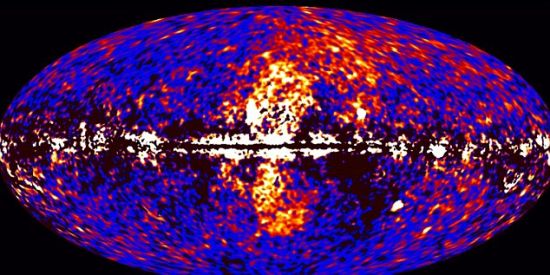 |
Scientists point out that two giant bubbles that extend outward from the galactic plane and emit gamma rays may be the key to discovery of dark matter.

German scientist Christopher Werniger said that through the statistical analysis of the data obtained from NASA's Fermi Space Telescope for a period of three and a half years, he may have discovered solid evidence of dark matter in the Milky Way.
On May 15th, Beijing time, the proportion of mysterious dark matter in the Milky Way was as high as two-thirds. Scientists have been searching for dark matter for decades, but no conclusive evidence has been found to prove the existence of this substance. Recently, Christopher Vineg, a scientist at the Max Planck Institute in Munich, Germany, said that he may have found the first solid evidence that it can prove the existence of dark matter.
Vigner said that he could find evidence of dark matter in the Milky Way through statistical analysis of data from NASA's Fermi Space Telescope for up to three and a half years. In the analysis, he found that the energy of the gamma ray was at its peak and appeared as a line in the spectrum. If his findings are confirmed, this line is conclusive evidence of the existence of dark matter.
Experts believe that jets released from supermassive black holes, such as black holes in the center of the Milky Way, interact with surrounding dark matter. This interaction is believed to be the source of high-energy gamma rays observed by Fermi and other telescopes. When the jet interacts with dark matter, the telescope can observe photons generated by the interaction.
After an analysis of the data for three and a half years, Vignig found that the energy of the gamma ray was at its peak and represented a line in the gamma ray spectrum. This can prove that dark matter interacts with the jet. Other scientists indicated that more research is still needed to verify the theory of Vinegar. Elliot Broome of Stanford University in the United States and Gon Conrad of Stockholm University in Sweden pointed out that much research is still needed to confirm this finding. Winigger admitted that he only came up with a preliminary result. His data only involved 50 photons, so there are other phenomena that may lead to the appearance of this line.
In December 2010, scientists involved in the Fermi telescope project discovered two giant bubbles extending outward from the black hole in the center of the Milky Way. The giant bubble is 25,000 light-years away from Earth, spanning more than half of the visible sky and entering into the constellation of Gemini from the constellation Virgo. They may be younger and have only about 1 million years of history. Both bubbles are usually obscured by dense gamma rays. Gamma rays are scattered throughout space and are formed by the mutual use of particles close to the speed of light and light in the Milky Way and interstellar gas.
Scientists pointed out that these two giant bubbles that extend from the galactic plane and emit gamma rays may be the key to finding dark matter. After analyzing the observation data of the Fermi telescope, the scientists discovered the existence of these two bubbles. After analysis, they found that the two bubbles had surprising features. They think that this bubble may be related to the theory of Wigig because they have some similar characteristics.
Seaweed Extract,Organic Fertilier,Foliar Application
Lower Blood Pressure Co., Ltd. , http://www.bjorganicfertilizer.com